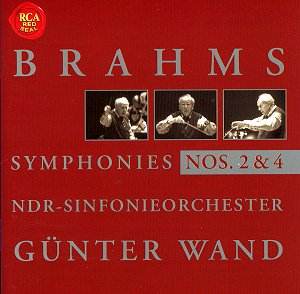These recordings (and the companion issue which couples the other two symphonies) constituted what I believe was Günter Wand’s first recorded cycle of the Brahms canon. On their last appearance the symphonies were spread over 3 CDs with numbers 1 and 2 each occupying a single disc (without a coupling!) but they now return much more economically packaged.
A further improvement is offered through the re-mastered sound. I acquired the previous RCA release of the complete set several years ago and while I liked the natural concert hall perspective the sound was a bit recessed. Some listeners might have found it dull. A comparison reveals that the re-mastering for this reissue is wholly successful. The bloom of the hall has been retained but the sound now has infinitely more presence and much more detail is audible.
As to the performances themselves, I have always felt that they are of the highest quality. Wand is an authoritative and humane guide to these scores and, above all, he consistently maintains the line and the shape of each movement. His pacing also strikes me as well nigh ideal throughout. This is a "traditional", experienced view of Brahms and profoundly satisfying it is too.
Wand’s players support him magnificently. Sample, for instance, the noble, lustrous horn solo in the first movement of the Second Symphony (Track 1, 13’ 07") which ushers in the serene coda. The burnished tone and generous phrasing heard here is quite marvellous and wholly unforced. This is by no means an isolated example.
The Second is generally regarded as Brahms’s "sunniest" symphony. However, as Jan Swafford has pointed out in his magisterial biography of the composer, there are tensions beneath the surface and the work has its darker moments. While Wand is excellent in laying out the lyrical side of the piece he is also suitably responsive to these darker passages. Thus, for example, the very opening of the second movement (Track 2) has a stoic gravity. Again, the point in the first movement where the heavy brass enters for the first time (Track 1, 16’ 25") brings grey clouds over the pastoral landscape. Wand and his players are most effective in these passages.
However, for most of the time geniality is the order of the day and Wand’s interpretation is no less successful in this regard. He gives a winning account of the innocent little Allegretto grazioso third movement while the finale is full of exuberance and joie de vivre, culminating in a properly exultant, brass-led coda.
The recording of the Fourth Symphony seems to me to be just as successful and for the same reasons. As in Number 2, he keeps the line flowing forward at all times. As before, he is well served by his orchestra and all concerned allow the music to breathe naturally.
Some may feel that the second movement could, with advantage, have been taken a notch or two faster (after all, it is marked Andante moderato) but I find Wand convincing at his chosen tempo. After this the following Allegretto grazioso offers an appropriate degree of contrast.
The passacaglia finale, based on a figure from the final chaconne movement in Bach’s Cantata BWV 150, Nach Dir, Herr, verlanget mich is a suitable tribute by Brahms to the German musical tradition of which he was so conscious. He uses the motif as the basis for no less than thirty short variations. Here the movement receives a trenchant and imposing performance and if perhaps Wand doesn’t quite match the searching individuality and incandescence of Carlos Kleiber’s wholly exceptional reading with the VPO on DG (who does?) his is still a fine and lucid account.
I have not heard Wand’s much more recent ‘live’ cycle (I believe that these earlier recordings were made under studio conditions) and some collectors may well wish to have his final thoughts on these great symphonies. However, the newer recordings are, of course, at full price. I doubt anyone investing in these mid-price reissues will feel short changed.
It has been a delight to reacquaint myself with these splendid performances now resplendent in much-improved sound and I can recommend them with confidence.
John Quinn


